Comparative Analysis: Waterfall vs. Agile Software Development at ASDA
VerifiedAdded on 2022/12/27
|12
|3215
|3
Report
AI Summary
This report provides a comparative analysis of the Waterfall and Agile software development methodologies, focusing on their application within the context of ASDA, a leading UK-based supermarket chain. The report begins by defining business information systems and their importance, followed by a detailed examination of the Waterfall model, including its sequential nature, phases, advantages, and disadvantages. Subsequently, the report investigates the Agile methodology, highlighting its iterative approach, key characteristics (such as individual and team interactions, working software over documentation, customer collaboration, and responding to change), advantages, and disadvantages. A direct comparison of the two methodologies is then presented, contrasting their approaches, processes, customer visibility, security, project completion efficiency, debugging, development processes, testing phases, and delivery methods. The analysis aims to provide a comprehensive understanding of both models to help organizations make informed decisions about which methodology best suits their software development needs, considering factors such as project scope, customer requirements, and the need for flexibility and adaptability. The report concludes by summarizing the key findings and offering insights into the suitability of each methodology for ASDA's specific business environment. The research is done to help ASDA choose the best method for software development and improve their operations, customer satisfaction, and adapt to business changes. This report is contributed to Desklib, which is a platform for students to find past papers and solved assignments.
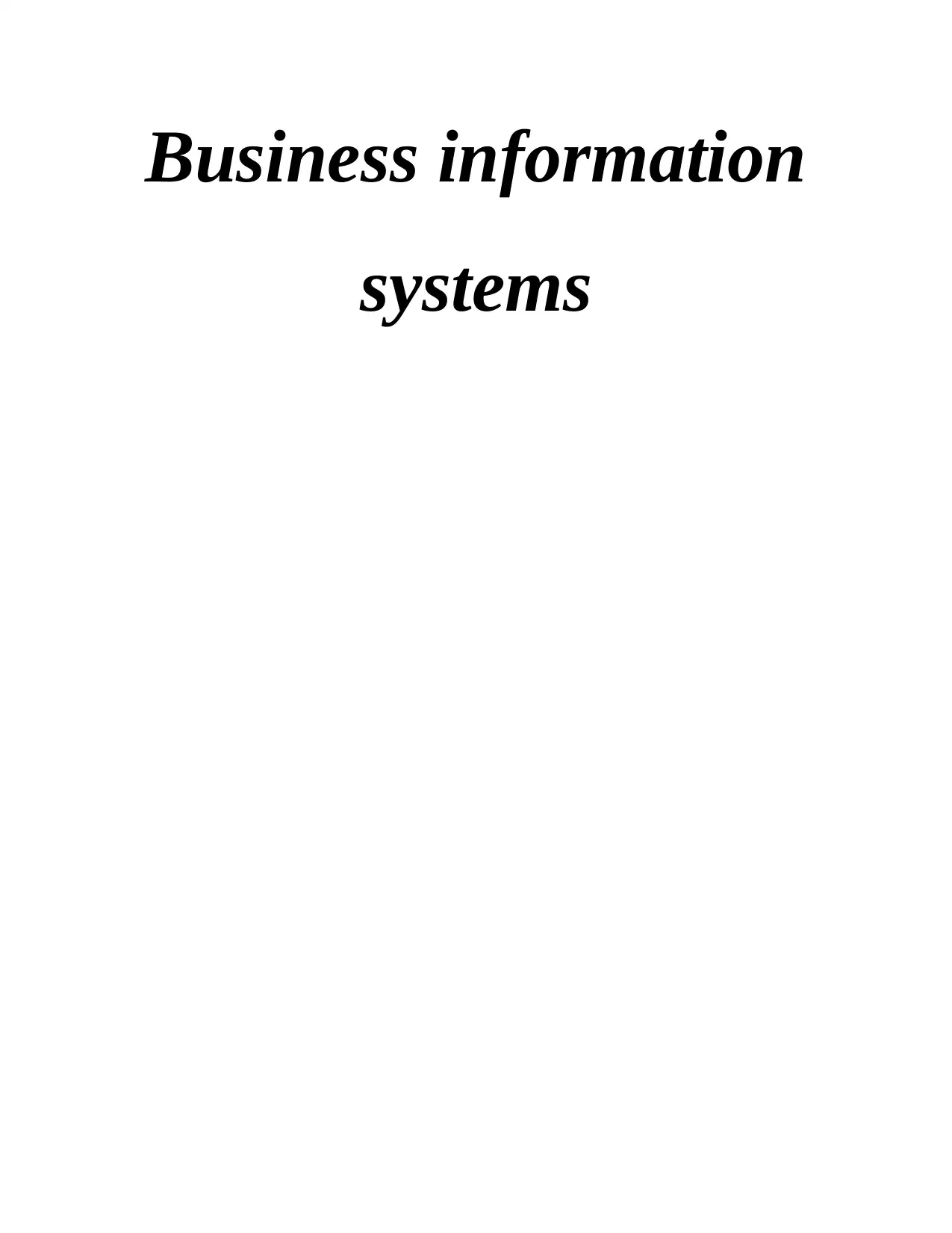
Business information
systems
systems
Paraphrase This Document
Need a fresh take? Get an instant paraphrase of this document with our AI Paraphraser
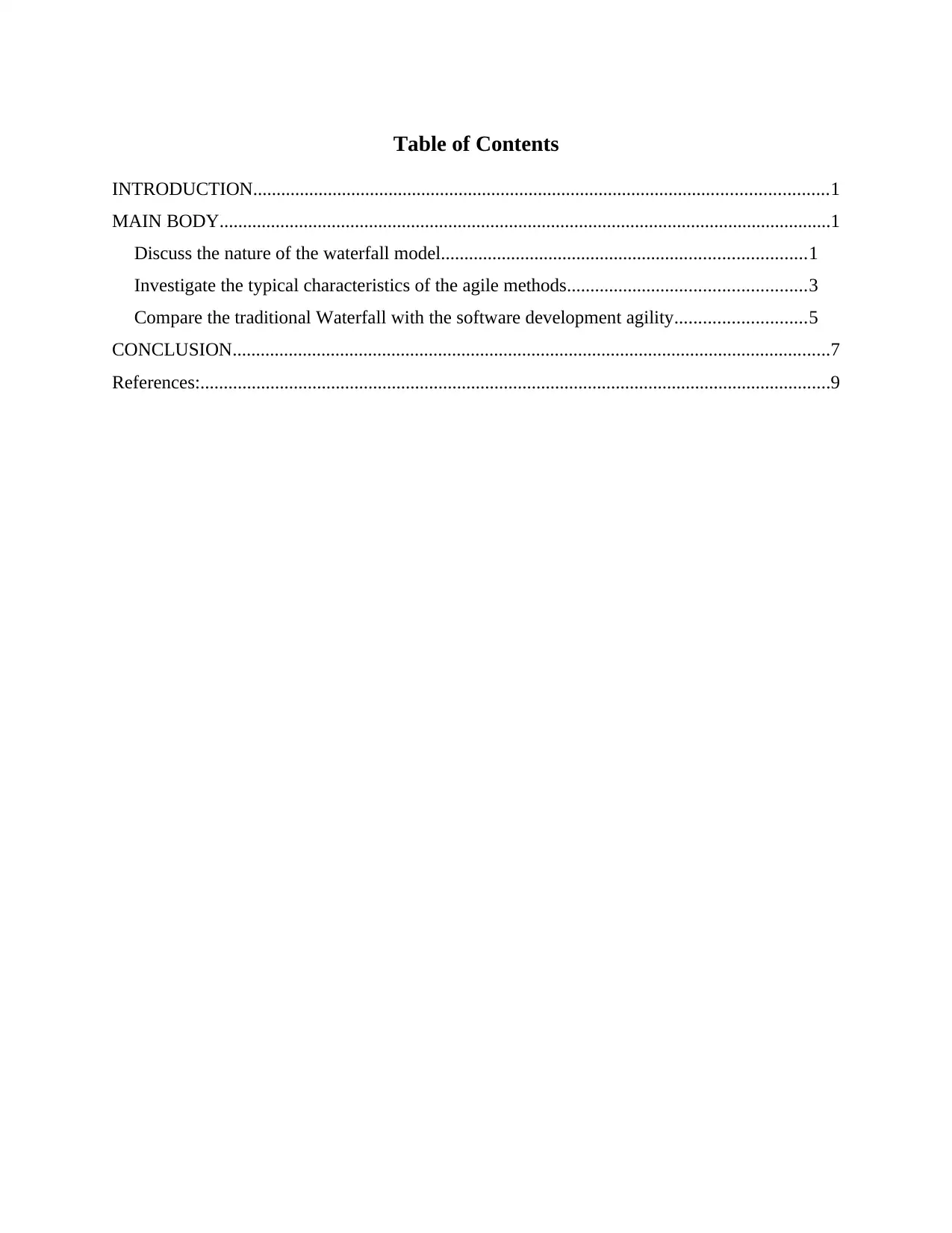
Table of Contents
INTRODUCTION...........................................................................................................................1
MAIN BODY...................................................................................................................................1
Discuss the nature of the waterfall model..............................................................................1
Investigate the typical characteristics of the agile methods...................................................3
Compare the traditional Waterfall with the software development agility............................5
CONCLUSION................................................................................................................................7
References:.......................................................................................................................................9
INTRODUCTION...........................................................................................................................1
MAIN BODY...................................................................................................................................1
Discuss the nature of the waterfall model..............................................................................1
Investigate the typical characteristics of the agile methods...................................................3
Compare the traditional Waterfall with the software development agility............................5
CONCLUSION................................................................................................................................7
References:.......................................................................................................................................9

⊘ This is a preview!⊘
Do you want full access?
Subscribe today to unlock all pages.

Trusted by 1+ million students worldwide
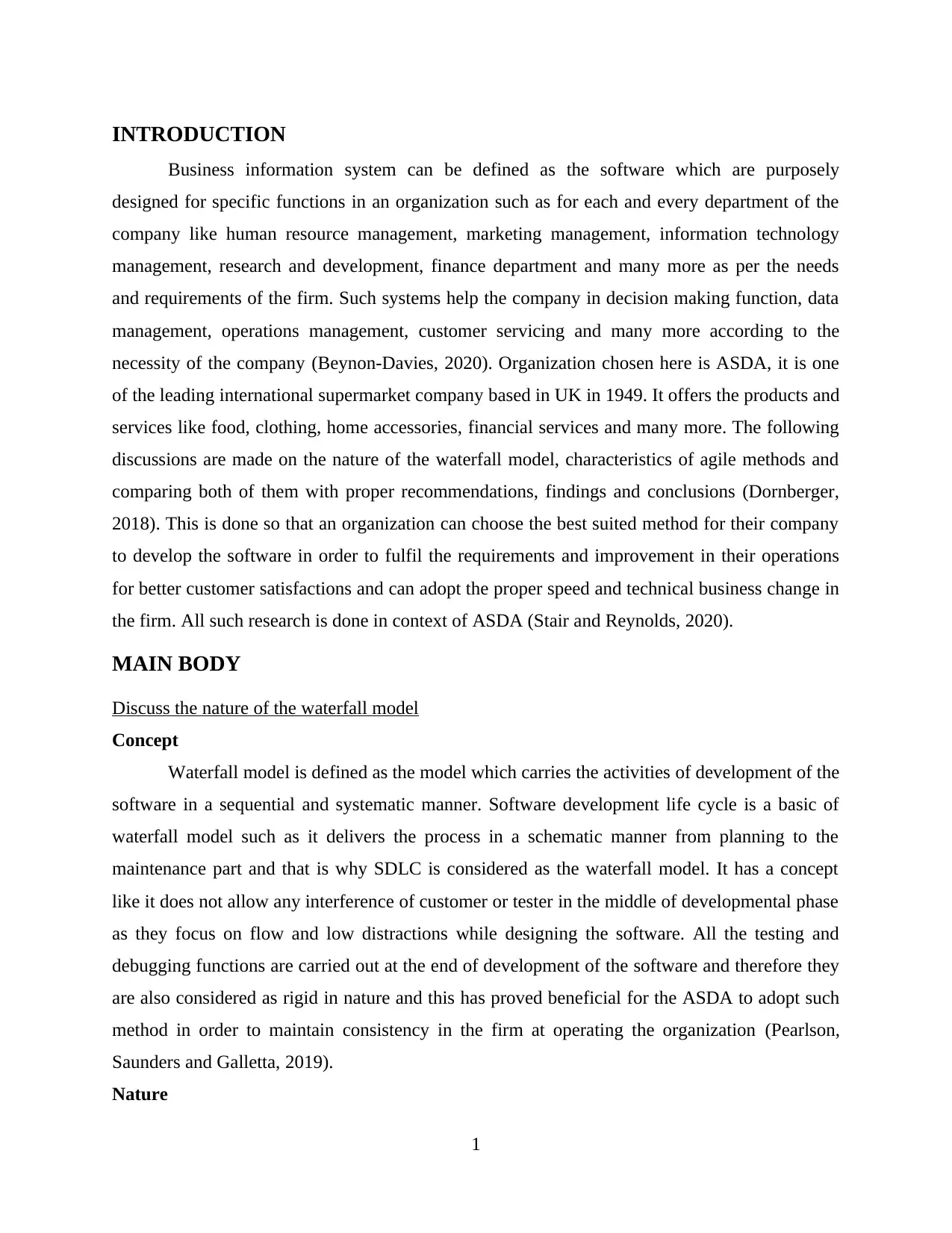
INTRODUCTION
Business information system can be defined as the software which are purposely
designed for specific functions in an organization such as for each and every department of the
company like human resource management, marketing management, information technology
management, research and development, finance department and many more as per the needs
and requirements of the firm. Such systems help the company in decision making function, data
management, operations management, customer servicing and many more according to the
necessity of the company (Beynon-Davies, 2020). Organization chosen here is ASDA, it is one
of the leading international supermarket company based in UK in 1949. It offers the products and
services like food, clothing, home accessories, financial services and many more. The following
discussions are made on the nature of the waterfall model, characteristics of agile methods and
comparing both of them with proper recommendations, findings and conclusions (Dornberger,
2018). This is done so that an organization can choose the best suited method for their company
to develop the software in order to fulfil the requirements and improvement in their operations
for better customer satisfactions and can adopt the proper speed and technical business change in
the firm. All such research is done in context of ASDA (Stair and Reynolds, 2020).
MAIN BODY
Discuss the nature of the waterfall model
Concept
Waterfall model is defined as the model which carries the activities of development of the
software in a sequential and systematic manner. Software development life cycle is a basic of
waterfall model such as it delivers the process in a schematic manner from planning to the
maintenance part and that is why SDLC is considered as the waterfall model. It has a concept
like it does not allow any interference of customer or tester in the middle of developmental phase
as they focus on flow and low distractions while designing the software. All the testing and
debugging functions are carried out at the end of development of the software and therefore they
are also considered as rigid in nature and this has proved beneficial for the ASDA to adopt such
method in order to maintain consistency in the firm at operating the organization (Pearlson,
Saunders and Galletta, 2019).
Nature
1
Business information system can be defined as the software which are purposely
designed for specific functions in an organization such as for each and every department of the
company like human resource management, marketing management, information technology
management, research and development, finance department and many more as per the needs
and requirements of the firm. Such systems help the company in decision making function, data
management, operations management, customer servicing and many more according to the
necessity of the company (Beynon-Davies, 2020). Organization chosen here is ASDA, it is one
of the leading international supermarket company based in UK in 1949. It offers the products and
services like food, clothing, home accessories, financial services and many more. The following
discussions are made on the nature of the waterfall model, characteristics of agile methods and
comparing both of them with proper recommendations, findings and conclusions (Dornberger,
2018). This is done so that an organization can choose the best suited method for their company
to develop the software in order to fulfil the requirements and improvement in their operations
for better customer satisfactions and can adopt the proper speed and technical business change in
the firm. All such research is done in context of ASDA (Stair and Reynolds, 2020).
MAIN BODY
Discuss the nature of the waterfall model
Concept
Waterfall model is defined as the model which carries the activities of development of the
software in a sequential and systematic manner. Software development life cycle is a basic of
waterfall model such as it delivers the process in a schematic manner from planning to the
maintenance part and that is why SDLC is considered as the waterfall model. It has a concept
like it does not allow any interference of customer or tester in the middle of developmental phase
as they focus on flow and low distractions while designing the software. All the testing and
debugging functions are carried out at the end of development of the software and therefore they
are also considered as rigid in nature and this has proved beneficial for the ASDA to adopt such
method in order to maintain consistency in the firm at operating the organization (Pearlson,
Saunders and Galletta, 2019).
Nature
1
Paraphrase This Document
Need a fresh take? Get an instant paraphrase of this document with our AI Paraphraser
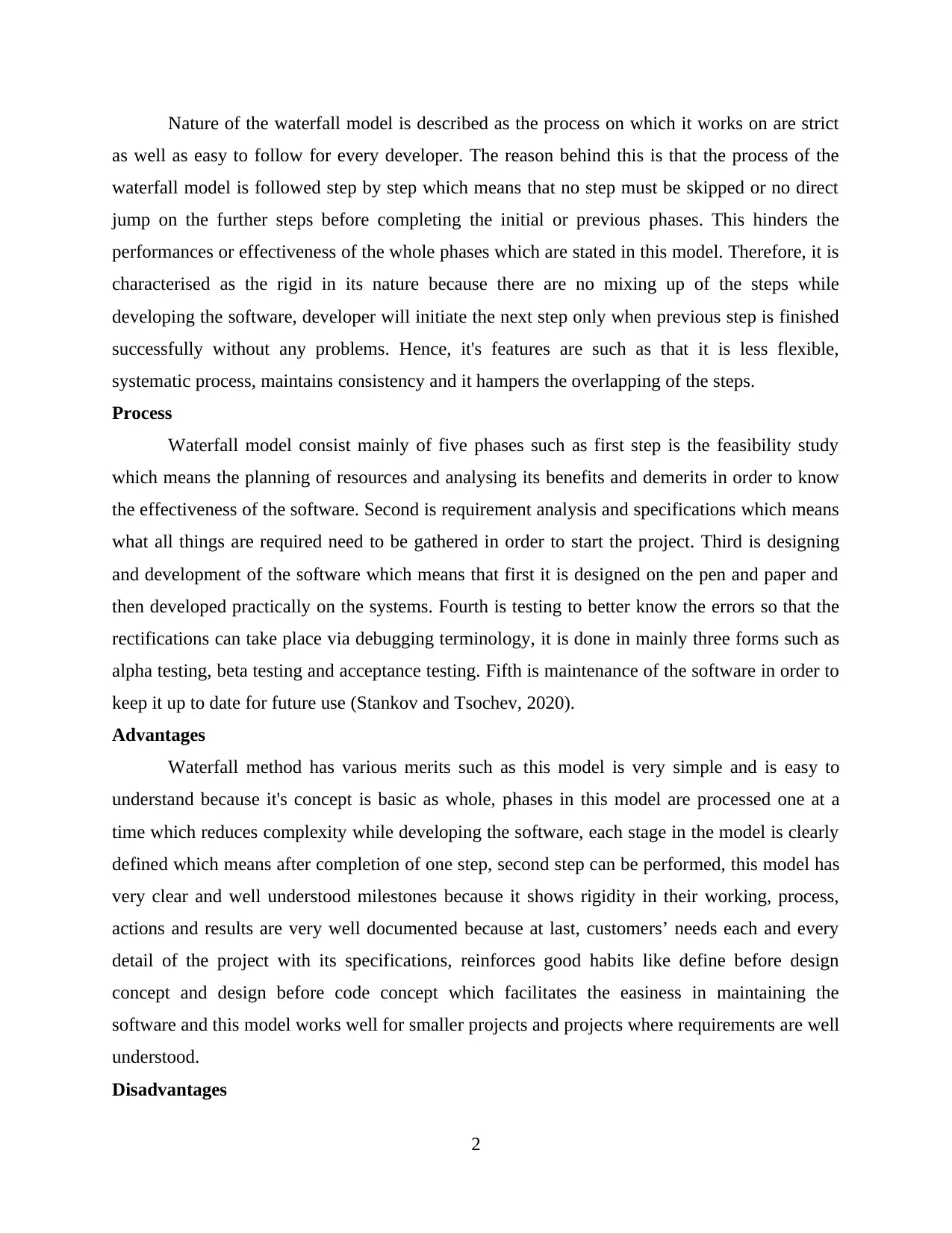
Nature of the waterfall model is described as the process on which it works on are strict
as well as easy to follow for every developer. The reason behind this is that the process of the
waterfall model is followed step by step which means that no step must be skipped or no direct
jump on the further steps before completing the initial or previous phases. This hinders the
performances or effectiveness of the whole phases which are stated in this model. Therefore, it is
characterised as the rigid in its nature because there are no mixing up of the steps while
developing the software, developer will initiate the next step only when previous step is finished
successfully without any problems. Hence, it's features are such as that it is less flexible,
systematic process, maintains consistency and it hampers the overlapping of the steps.
Process
Waterfall model consist mainly of five phases such as first step is the feasibility study
which means the planning of resources and analysing its benefits and demerits in order to know
the effectiveness of the software. Second is requirement analysis and specifications which means
what all things are required need to be gathered in order to start the project. Third is designing
and development of the software which means that first it is designed on the pen and paper and
then developed practically on the systems. Fourth is testing to better know the errors so that the
rectifications can take place via debugging terminology, it is done in mainly three forms such as
alpha testing, beta testing and acceptance testing. Fifth is maintenance of the software in order to
keep it up to date for future use (Stankov and Tsochev, 2020).
Advantages
Waterfall method has various merits such as this model is very simple and is easy to
understand because it's concept is basic as whole, phases in this model are processed one at a
time which reduces complexity while developing the software, each stage in the model is clearly
defined which means after completion of one step, second step can be performed, this model has
very clear and well understood milestones because it shows rigidity in their working, process,
actions and results are very well documented because at last, customers’ needs each and every
detail of the project with its specifications, reinforces good habits like define before design
concept and design before code concept which facilitates the easiness in maintaining the
software and this model works well for smaller projects and projects where requirements are well
understood.
Disadvantages
2
as well as easy to follow for every developer. The reason behind this is that the process of the
waterfall model is followed step by step which means that no step must be skipped or no direct
jump on the further steps before completing the initial or previous phases. This hinders the
performances or effectiveness of the whole phases which are stated in this model. Therefore, it is
characterised as the rigid in its nature because there are no mixing up of the steps while
developing the software, developer will initiate the next step only when previous step is finished
successfully without any problems. Hence, it's features are such as that it is less flexible,
systematic process, maintains consistency and it hampers the overlapping of the steps.
Process
Waterfall model consist mainly of five phases such as first step is the feasibility study
which means the planning of resources and analysing its benefits and demerits in order to know
the effectiveness of the software. Second is requirement analysis and specifications which means
what all things are required need to be gathered in order to start the project. Third is designing
and development of the software which means that first it is designed on the pen and paper and
then developed practically on the systems. Fourth is testing to better know the errors so that the
rectifications can take place via debugging terminology, it is done in mainly three forms such as
alpha testing, beta testing and acceptance testing. Fifth is maintenance of the software in order to
keep it up to date for future use (Stankov and Tsochev, 2020).
Advantages
Waterfall method has various merits such as this model is very simple and is easy to
understand because it's concept is basic as whole, phases in this model are processed one at a
time which reduces complexity while developing the software, each stage in the model is clearly
defined which means after completion of one step, second step can be performed, this model has
very clear and well understood milestones because it shows rigidity in their working, process,
actions and results are very well documented because at last, customers’ needs each and every
detail of the project with its specifications, reinforces good habits like define before design
concept and design before code concept which facilitates the easiness in maintaining the
software and this model works well for smaller projects and projects where requirements are well
understood.
Disadvantages
2
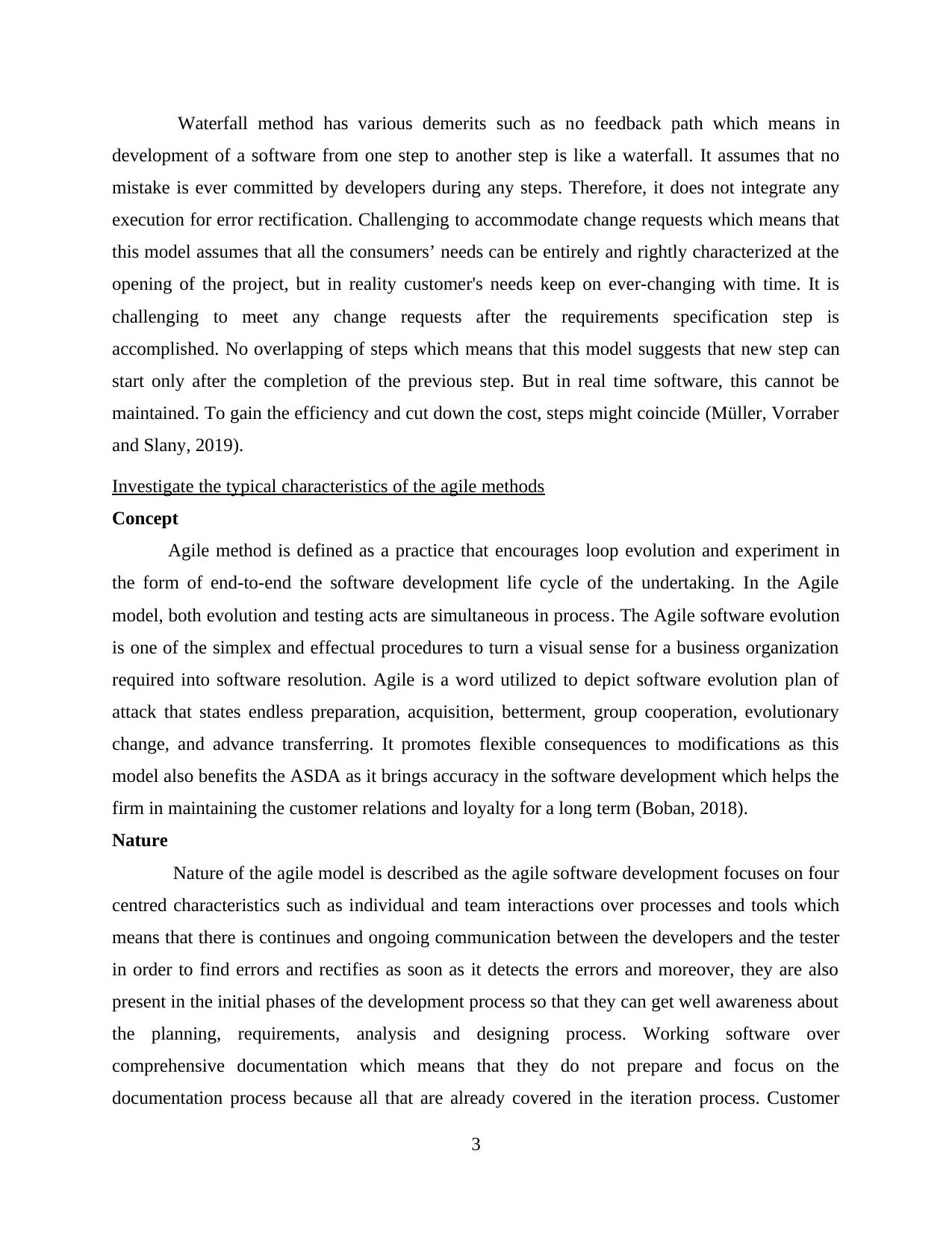
Waterfall method has various demerits such as no feedback path which means in
development of a software from one step to another step is like a waterfall. It assumes that no
mistake is ever committed by developers during any steps. Therefore, it does not integrate any
execution for error rectification. Challenging to accommodate change requests which means that
this model assumes that all the consumers’ needs can be entirely and rightly characterized at the
opening of the project, but in reality customer's needs keep on ever-changing with time. It is
challenging to meet any change requests after the requirements specification step is
accomplished. No overlapping of steps which means that this model suggests that new step can
start only after the completion of the previous step. But in real time software, this cannot be
maintained. To gain the efficiency and cut down the cost, steps might coincide (Müller, Vorraber
and Slany, 2019).
Investigate the typical characteristics of the agile methods
Concept
Agile method is defined as a practice that encourages loop evolution and experiment in
the form of end-to-end the software development life cycle of the undertaking. In the Agile
model, both evolution and testing acts are simultaneous in process. The Agile software evolution
is one of the simplex and effectual procedures to turn a visual sense for a business organization
required into software resolution. Agile is a word utilized to depict software evolution plan of
attack that states endless preparation, acquisition, betterment, group cooperation, evolutionary
change, and advance transferring. It promotes flexible consequences to modifications as this
model also benefits the ASDA as it brings accuracy in the software development which helps the
firm in maintaining the customer relations and loyalty for a long term (Boban, 2018).
Nature
Nature of the agile model is described as the agile software development focuses on four
centred characteristics such as individual and team interactions over processes and tools which
means that there is continues and ongoing communication between the developers and the tester
in order to find errors and rectifies as soon as it detects the errors and moreover, they are also
present in the initial phases of the development process so that they can get well awareness about
the planning, requirements, analysis and designing process. Working software over
comprehensive documentation which means that they do not prepare and focus on the
documentation process because all that are already covered in the iteration process. Customer
3
development of a software from one step to another step is like a waterfall. It assumes that no
mistake is ever committed by developers during any steps. Therefore, it does not integrate any
execution for error rectification. Challenging to accommodate change requests which means that
this model assumes that all the consumers’ needs can be entirely and rightly characterized at the
opening of the project, but in reality customer's needs keep on ever-changing with time. It is
challenging to meet any change requests after the requirements specification step is
accomplished. No overlapping of steps which means that this model suggests that new step can
start only after the completion of the previous step. But in real time software, this cannot be
maintained. To gain the efficiency and cut down the cost, steps might coincide (Müller, Vorraber
and Slany, 2019).
Investigate the typical characteristics of the agile methods
Concept
Agile method is defined as a practice that encourages loop evolution and experiment in
the form of end-to-end the software development life cycle of the undertaking. In the Agile
model, both evolution and testing acts are simultaneous in process. The Agile software evolution
is one of the simplex and effectual procedures to turn a visual sense for a business organization
required into software resolution. Agile is a word utilized to depict software evolution plan of
attack that states endless preparation, acquisition, betterment, group cooperation, evolutionary
change, and advance transferring. It promotes flexible consequences to modifications as this
model also benefits the ASDA as it brings accuracy in the software development which helps the
firm in maintaining the customer relations and loyalty for a long term (Boban, 2018).
Nature
Nature of the agile model is described as the agile software development focuses on four
centred characteristics such as individual and team interactions over processes and tools which
means that there is continues and ongoing communication between the developers and the tester
in order to find errors and rectifies as soon as it detects the errors and moreover, they are also
present in the initial phases of the development process so that they can get well awareness about
the planning, requirements, analysis and designing process. Working software over
comprehensive documentation which means that they do not prepare and focus on the
documentation process because all that are already covered in the iteration process. Customer
3
⊘ This is a preview!⊘
Do you want full access?
Subscribe today to unlock all pages.

Trusted by 1+ million students worldwide
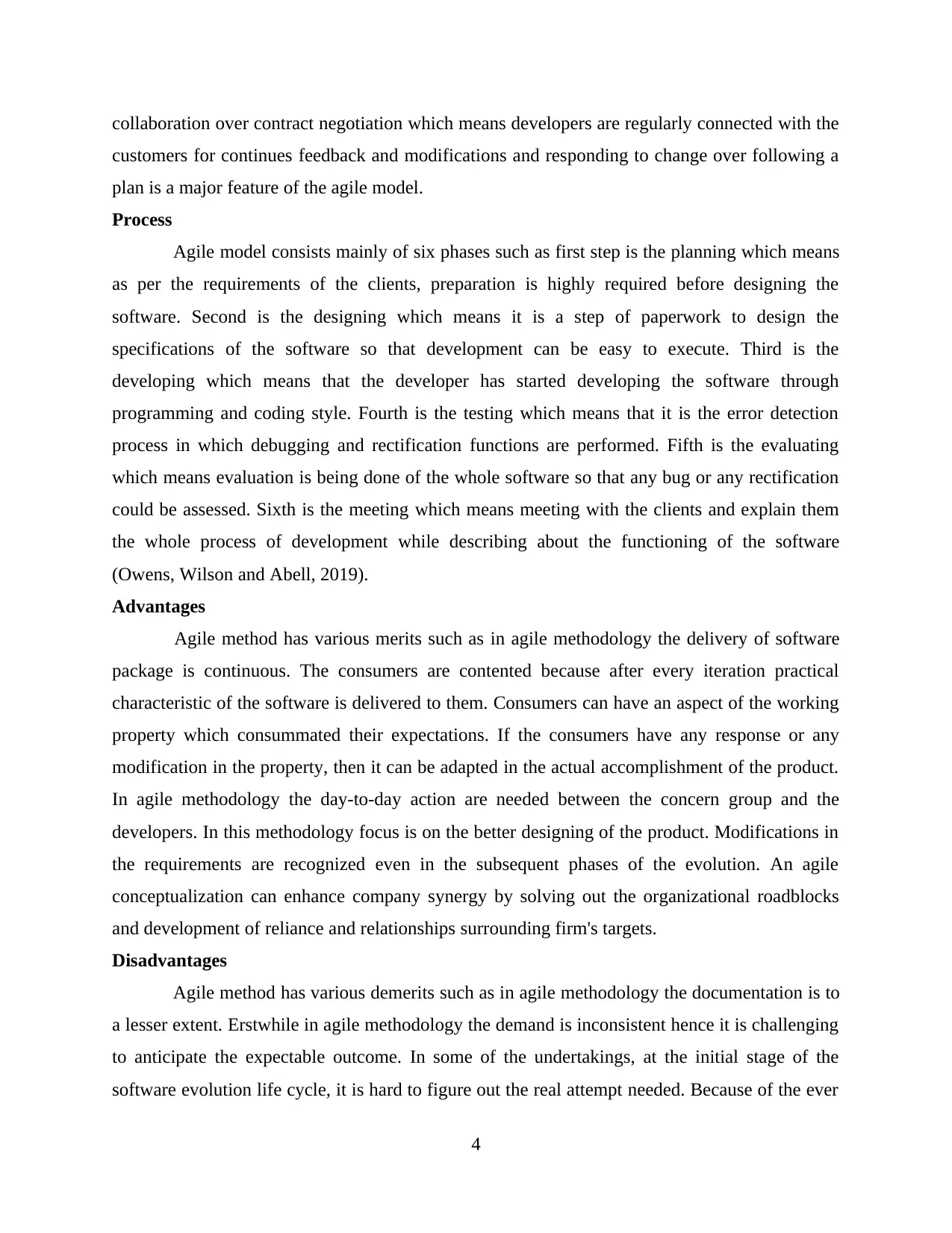
collaboration over contract negotiation which means developers are regularly connected with the
customers for continues feedback and modifications and responding to change over following a
plan is a major feature of the agile model.
Process
Agile model consists mainly of six phases such as first step is the planning which means
as per the requirements of the clients, preparation is highly required before designing the
software. Second is the designing which means it is a step of paperwork to design the
specifications of the software so that development can be easy to execute. Third is the
developing which means that the developer has started developing the software through
programming and coding style. Fourth is the testing which means that it is the error detection
process in which debugging and rectification functions are performed. Fifth is the evaluating
which means evaluation is being done of the whole software so that any bug or any rectification
could be assessed. Sixth is the meeting which means meeting with the clients and explain them
the whole process of development while describing about the functioning of the software
(Owens, Wilson and Abell, 2019).
Advantages
Agile method has various merits such as in agile methodology the delivery of software
package is continuous. The consumers are contented because after every iteration practical
characteristic of the software is delivered to them. Consumers can have an aspect of the working
property which consummated their expectations. If the consumers have any response or any
modification in the property, then it can be adapted in the actual accomplishment of the product.
In agile methodology the day-to-day action are needed between the concern group and the
developers. In this methodology focus is on the better designing of the product. Modifications in
the requirements are recognized even in the subsequent phases of the evolution. An agile
conceptualization can enhance company synergy by solving out the organizational roadblocks
and development of reliance and relationships surrounding firm's targets.
Disadvantages
Agile method has various demerits such as in agile methodology the documentation is to
a lesser extent. Erstwhile in agile methodology the demand is inconsistent hence it is challenging
to anticipate the expectable outcome. In some of the undertakings, at the initial stage of the
software evolution life cycle, it is hard to figure out the real attempt needed. Because of the ever
4
customers for continues feedback and modifications and responding to change over following a
plan is a major feature of the agile model.
Process
Agile model consists mainly of six phases such as first step is the planning which means
as per the requirements of the clients, preparation is highly required before designing the
software. Second is the designing which means it is a step of paperwork to design the
specifications of the software so that development can be easy to execute. Third is the
developing which means that the developer has started developing the software through
programming and coding style. Fourth is the testing which means that it is the error detection
process in which debugging and rectification functions are performed. Fifth is the evaluating
which means evaluation is being done of the whole software so that any bug or any rectification
could be assessed. Sixth is the meeting which means meeting with the clients and explain them
the whole process of development while describing about the functioning of the software
(Owens, Wilson and Abell, 2019).
Advantages
Agile method has various merits such as in agile methodology the delivery of software
package is continuous. The consumers are contented because after every iteration practical
characteristic of the software is delivered to them. Consumers can have an aspect of the working
property which consummated their expectations. If the consumers have any response or any
modification in the property, then it can be adapted in the actual accomplishment of the product.
In agile methodology the day-to-day action are needed between the concern group and the
developers. In this methodology focus is on the better designing of the product. Modifications in
the requirements are recognized even in the subsequent phases of the evolution. An agile
conceptualization can enhance company synergy by solving out the organizational roadblocks
and development of reliance and relationships surrounding firm's targets.
Disadvantages
Agile method has various demerits such as in agile methodology the documentation is to
a lesser extent. Erstwhile in agile methodology the demand is inconsistent hence it is challenging
to anticipate the expectable outcome. In some of the undertakings, at the initial stage of the
software evolution life cycle, it is hard to figure out the real attempt needed. Because of the ever
4
Paraphrase This Document
Need a fresh take? Get an instant paraphrase of this document with our AI Paraphraser
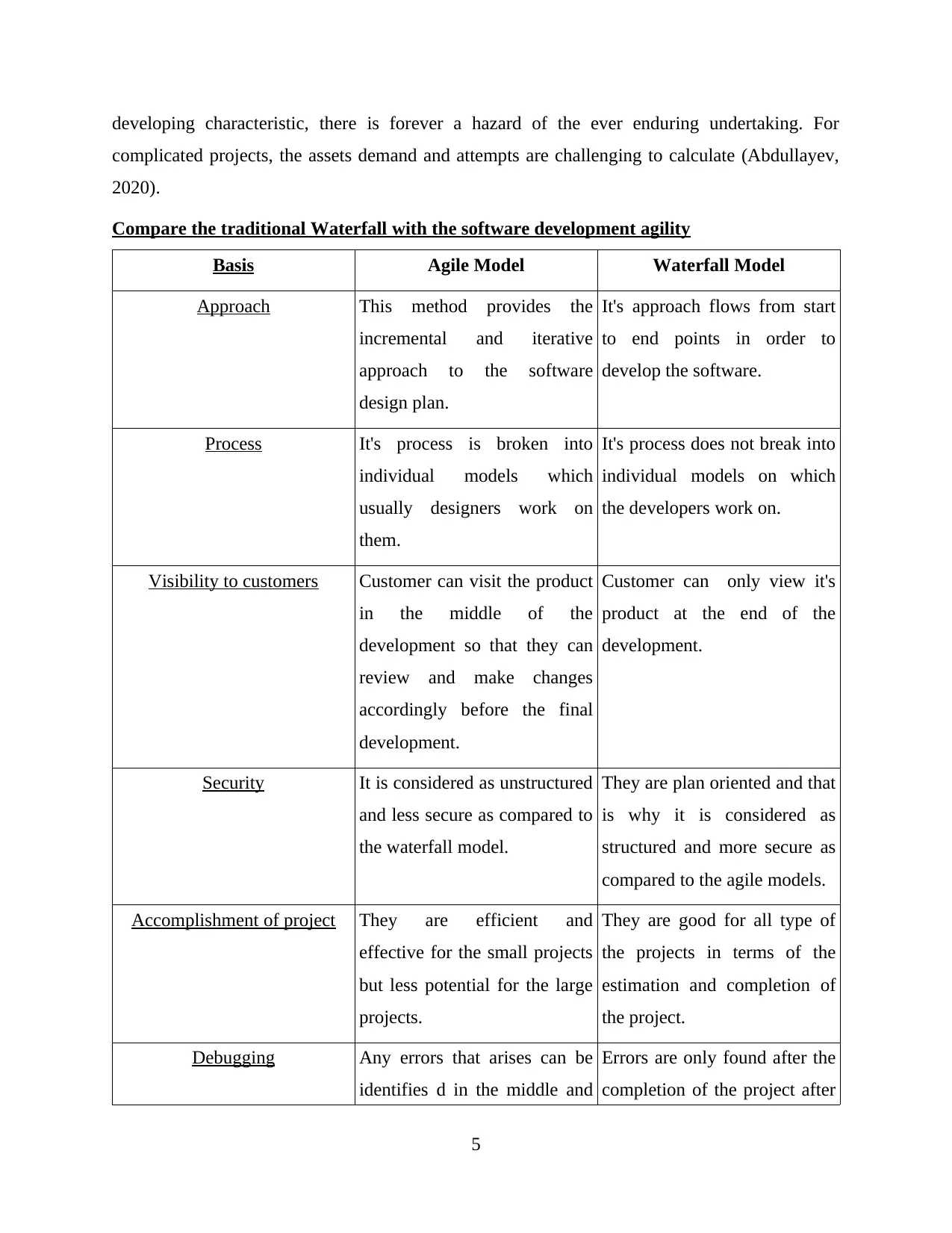
developing characteristic, there is forever a hazard of the ever enduring undertaking. For
complicated projects, the assets demand and attempts are challenging to calculate (Abdullayev,
2020).
Compare the traditional Waterfall with the software development agility
Basis Agile Model Waterfall Model
Approach This method provides the
incremental and iterative
approach to the software
design plan.
It's approach flows from start
to end points in order to
develop the software.
Process It's process is broken into
individual models which
usually designers work on
them.
It's process does not break into
individual models on which
the developers work on.
Visibility to customers Customer can visit the product
in the middle of the
development so that they can
review and make changes
accordingly before the final
development.
Customer can only view it's
product at the end of the
development.
Security It is considered as unstructured
and less secure as compared to
the waterfall model.
They are plan oriented and that
is why it is considered as
structured and more secure as
compared to the agile models.
Accomplishment of project They are efficient and
effective for the small projects
but less potential for the large
projects.
They are good for all type of
the projects in terms of the
estimation and completion of
the project.
Debugging Any errors that arises can be
identifies d in the middle and
Errors are only found after the
completion of the project after
5
complicated projects, the assets demand and attempts are challenging to calculate (Abdullayev,
2020).
Compare the traditional Waterfall with the software development agility
Basis Agile Model Waterfall Model
Approach This method provides the
incremental and iterative
approach to the software
design plan.
It's approach flows from start
to end points in order to
develop the software.
Process It's process is broken into
individual models which
usually designers work on
them.
It's process does not break into
individual models on which
the developers work on.
Visibility to customers Customer can visit the product
in the middle of the
development so that they can
review and make changes
accordingly before the final
development.
Customer can only view it's
product at the end of the
development.
Security It is considered as unstructured
and less secure as compared to
the waterfall model.
They are plan oriented and that
is why it is considered as
structured and more secure as
compared to the agile models.
Accomplishment of project They are efficient and
effective for the small projects
but less potential for the large
projects.
They are good for all type of
the projects in terms of the
estimation and completion of
the project.
Debugging Any errors that arises can be
identifies d in the middle and
Errors are only found after the
completion of the project after
5
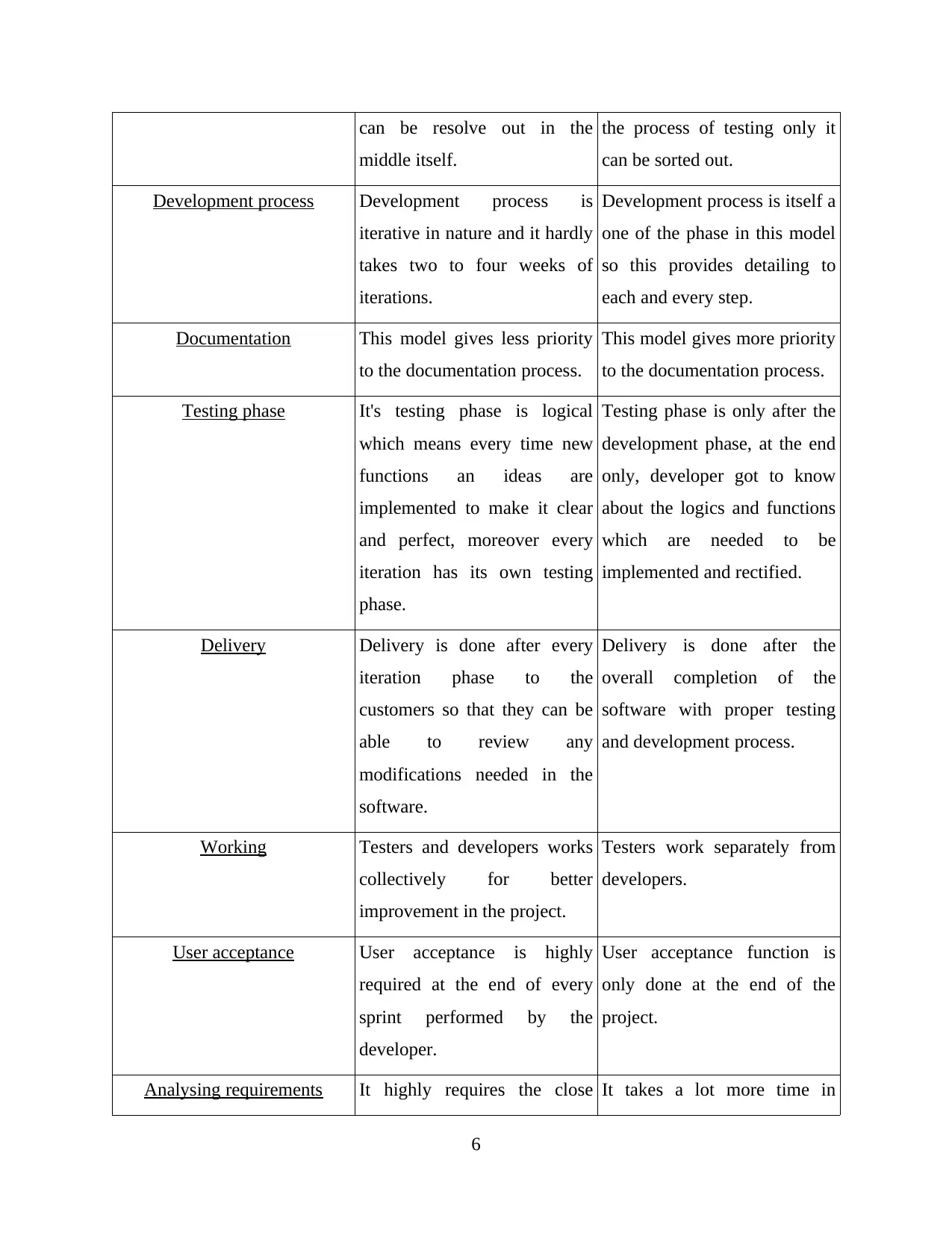
can be resolve out in the
middle itself.
the process of testing only it
can be sorted out.
Development process Development process is
iterative in nature and it hardly
takes two to four weeks of
iterations.
Development process is itself a
one of the phase in this model
so this provides detailing to
each and every step.
Documentation This model gives less priority
to the documentation process.
This model gives more priority
to the documentation process.
Testing phase It's testing phase is logical
which means every time new
functions an ideas are
implemented to make it clear
and perfect, moreover every
iteration has its own testing
phase.
Testing phase is only after the
development phase, at the end
only, developer got to know
about the logics and functions
which are needed to be
implemented and rectified.
Delivery Delivery is done after every
iteration phase to the
customers so that they can be
able to review any
modifications needed in the
software.
Delivery is done after the
overall completion of the
software with proper testing
and development process.
Working Testers and developers works
collectively for better
improvement in the project.
Testers work separately from
developers.
User acceptance User acceptance is highly
required at the end of every
sprint performed by the
developer.
User acceptance function is
only done at the end of the
project.
Analysing requirements It highly requires the close It takes a lot more time in
6
middle itself.
the process of testing only it
can be sorted out.
Development process Development process is
iterative in nature and it hardly
takes two to four weeks of
iterations.
Development process is itself a
one of the phase in this model
so this provides detailing to
each and every step.
Documentation This model gives less priority
to the documentation process.
This model gives more priority
to the documentation process.
Testing phase It's testing phase is logical
which means every time new
functions an ideas are
implemented to make it clear
and perfect, moreover every
iteration has its own testing
phase.
Testing phase is only after the
development phase, at the end
only, developer got to know
about the logics and functions
which are needed to be
implemented and rectified.
Delivery Delivery is done after every
iteration phase to the
customers so that they can be
able to review any
modifications needed in the
software.
Delivery is done after the
overall completion of the
software with proper testing
and development process.
Working Testers and developers works
collectively for better
improvement in the project.
Testers work separately from
developers.
User acceptance User acceptance is highly
required at the end of every
sprint performed by the
developer.
User acceptance function is
only done at the end of the
project.
Analysing requirements It highly requires the close It takes a lot more time in
6
⊘ This is a preview!⊘
Do you want full access?
Subscribe today to unlock all pages.

Trusted by 1+ million students worldwide
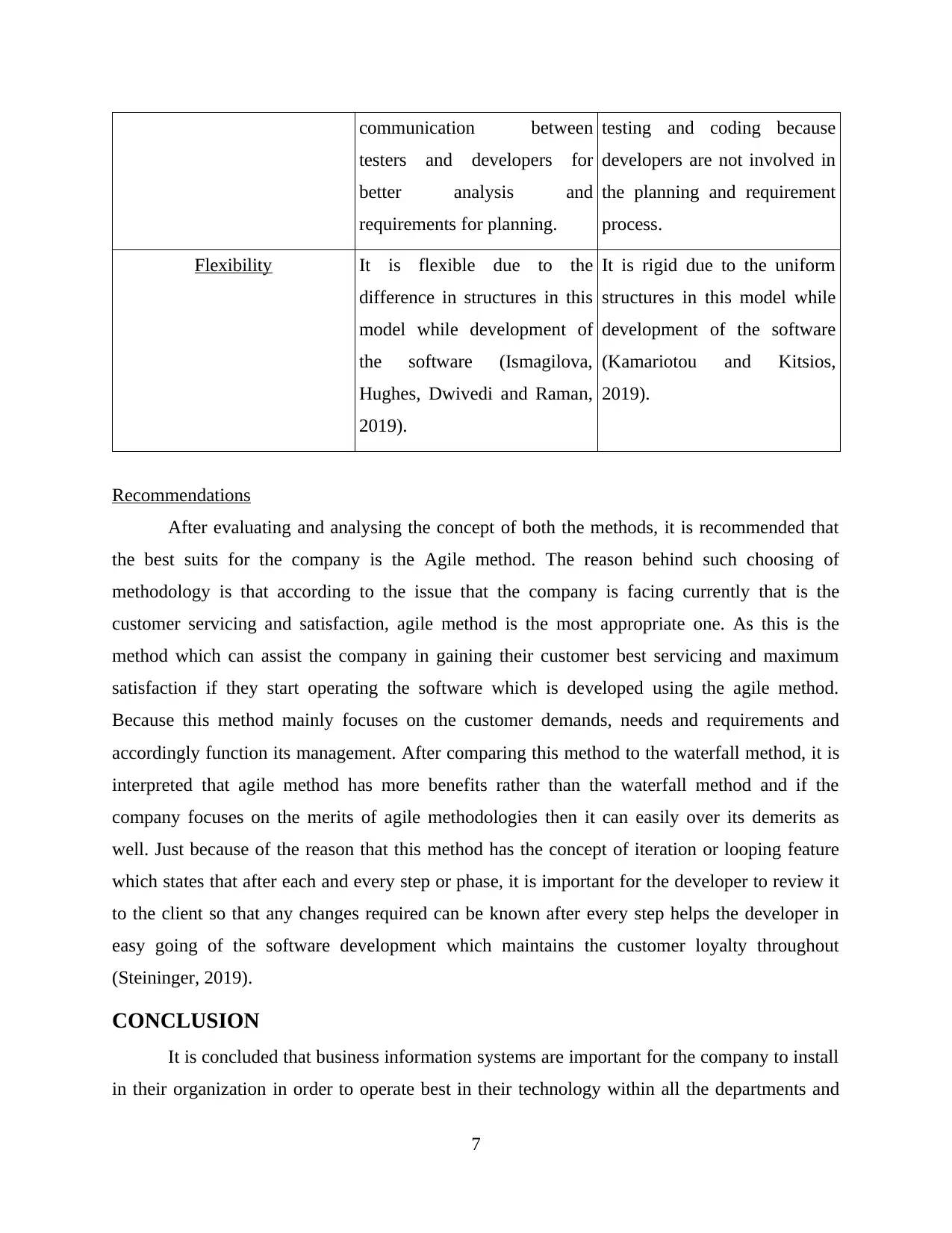
communication between
testers and developers for
better analysis and
requirements for planning.
testing and coding because
developers are not involved in
the planning and requirement
process.
Flexibility It is flexible due to the
difference in structures in this
model while development of
the software (Ismagilova,
Hughes, Dwivedi and Raman,
2019).
It is rigid due to the uniform
structures in this model while
development of the software
(Kamariotou and Kitsios,
2019).
Recommendations
After evaluating and analysing the concept of both the methods, it is recommended that
the best suits for the company is the Agile method. The reason behind such choosing of
methodology is that according to the issue that the company is facing currently that is the
customer servicing and satisfaction, agile method is the most appropriate one. As this is the
method which can assist the company in gaining their customer best servicing and maximum
satisfaction if they start operating the software which is developed using the agile method.
Because this method mainly focuses on the customer demands, needs and requirements and
accordingly function its management. After comparing this method to the waterfall method, it is
interpreted that agile method has more benefits rather than the waterfall method and if the
company focuses on the merits of agile methodologies then it can easily over its demerits as
well. Just because of the reason that this method has the concept of iteration or looping feature
which states that after each and every step or phase, it is important for the developer to review it
to the client so that any changes required can be known after every step helps the developer in
easy going of the software development which maintains the customer loyalty throughout
(Steininger, 2019).
CONCLUSION
It is concluded that business information systems are important for the company to install
in their organization in order to operate best in their technology within all the departments and
7
testers and developers for
better analysis and
requirements for planning.
testing and coding because
developers are not involved in
the planning and requirement
process.
Flexibility It is flexible due to the
difference in structures in this
model while development of
the software (Ismagilova,
Hughes, Dwivedi and Raman,
2019).
It is rigid due to the uniform
structures in this model while
development of the software
(Kamariotou and Kitsios,
2019).
Recommendations
After evaluating and analysing the concept of both the methods, it is recommended that
the best suits for the company is the Agile method. The reason behind such choosing of
methodology is that according to the issue that the company is facing currently that is the
customer servicing and satisfaction, agile method is the most appropriate one. As this is the
method which can assist the company in gaining their customer best servicing and maximum
satisfaction if they start operating the software which is developed using the agile method.
Because this method mainly focuses on the customer demands, needs and requirements and
accordingly function its management. After comparing this method to the waterfall method, it is
interpreted that agile method has more benefits rather than the waterfall method and if the
company focuses on the merits of agile methodologies then it can easily over its demerits as
well. Just because of the reason that this method has the concept of iteration or looping feature
which states that after each and every step or phase, it is important for the developer to review it
to the client so that any changes required can be known after every step helps the developer in
easy going of the software development which maintains the customer loyalty throughout
(Steininger, 2019).
CONCLUSION
It is concluded that business information systems are important for the company to install
in their organization in order to operate best in their technology within all the departments and
7
Paraphrase This Document
Need a fresh take? Get an instant paraphrase of this document with our AI Paraphraser
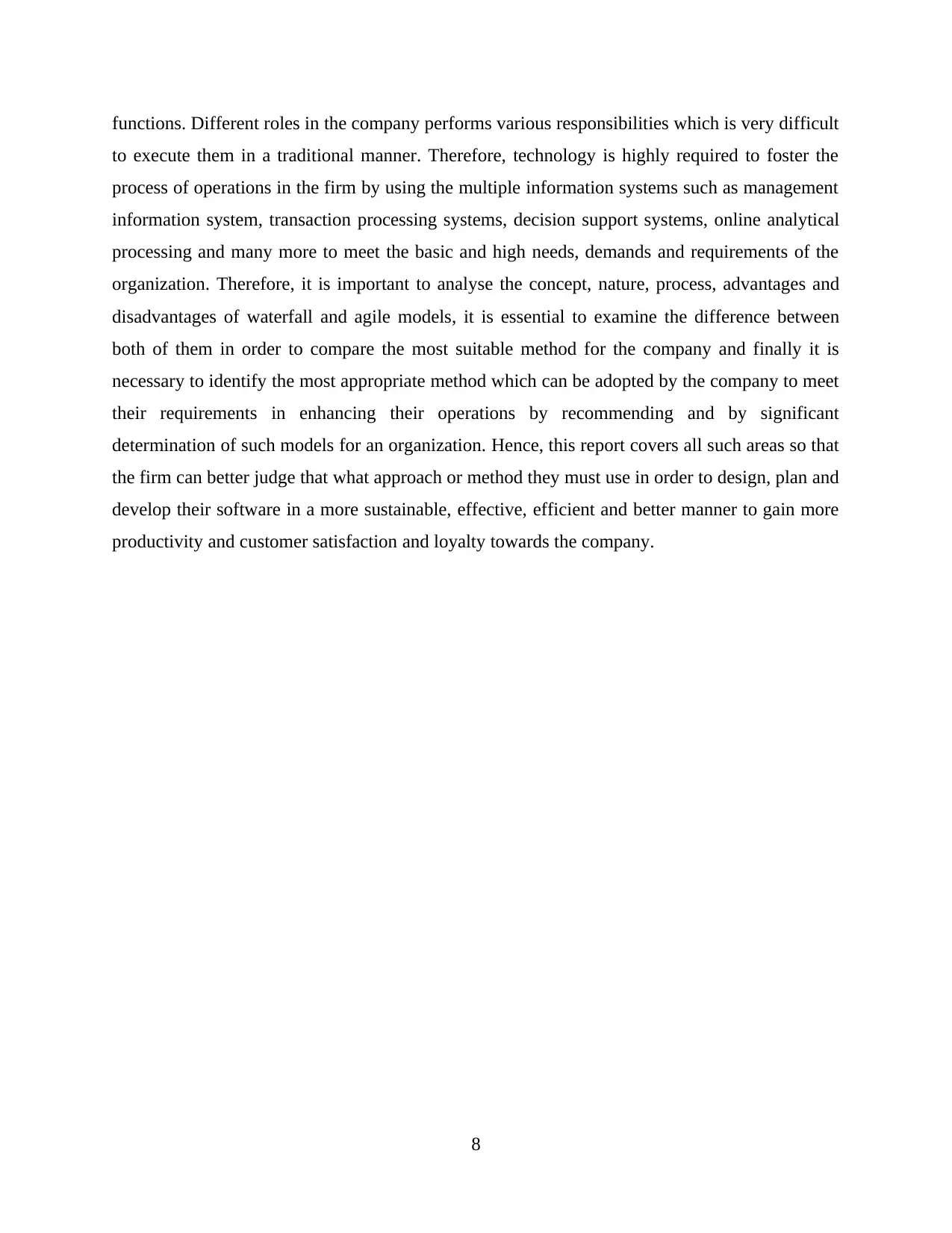
functions. Different roles in the company performs various responsibilities which is very difficult
to execute them in a traditional manner. Therefore, technology is highly required to foster the
process of operations in the firm by using the multiple information systems such as management
information system, transaction processing systems, decision support systems, online analytical
processing and many more to meet the basic and high needs, demands and requirements of the
organization. Therefore, it is important to analyse the concept, nature, process, advantages and
disadvantages of waterfall and agile models, it is essential to examine the difference between
both of them in order to compare the most suitable method for the company and finally it is
necessary to identify the most appropriate method which can be adopted by the company to meet
their requirements in enhancing their operations by recommending and by significant
determination of such models for an organization. Hence, this report covers all such areas so that
the firm can better judge that what approach or method they must use in order to design, plan and
develop their software in a more sustainable, effective, efficient and better manner to gain more
productivity and customer satisfaction and loyalty towards the company.
8
to execute them in a traditional manner. Therefore, technology is highly required to foster the
process of operations in the firm by using the multiple information systems such as management
information system, transaction processing systems, decision support systems, online analytical
processing and many more to meet the basic and high needs, demands and requirements of the
organization. Therefore, it is important to analyse the concept, nature, process, advantages and
disadvantages of waterfall and agile models, it is essential to examine the difference between
both of them in order to compare the most suitable method for the company and finally it is
necessary to identify the most appropriate method which can be adopted by the company to meet
their requirements in enhancing their operations by recommending and by significant
determination of such models for an organization. Hence, this report covers all such areas so that
the firm can better judge that what approach or method they must use in order to design, plan and
develop their software in a more sustainable, effective, efficient and better manner to gain more
productivity and customer satisfaction and loyalty towards the company.
8
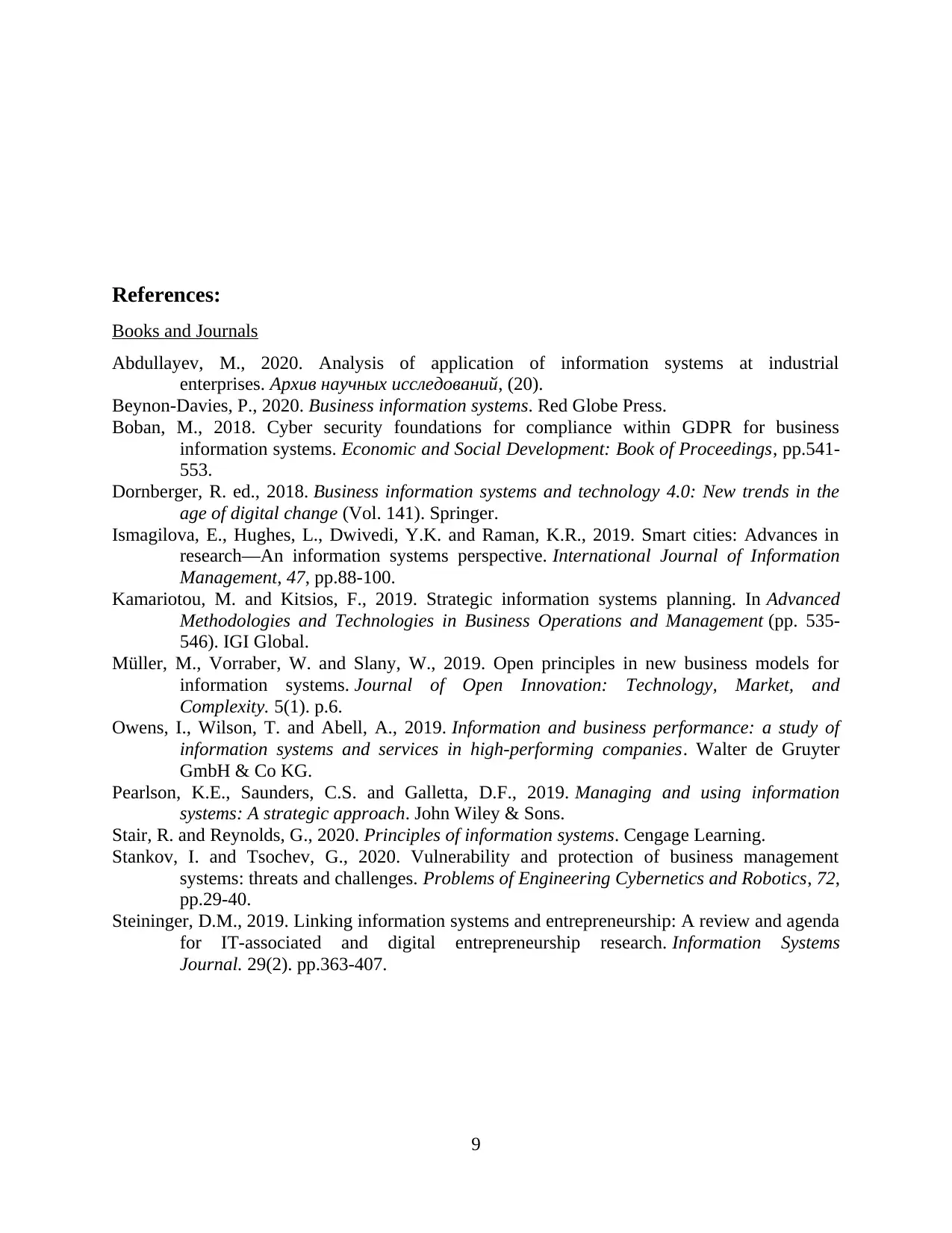
References:
Books and Journals
Abdullayev, M., 2020. Analysis of application of information systems at industrial
enterprises. Архив научных исследований, (20).
Beynon-Davies, P., 2020. Business information systems. Red Globe Press.
Boban, M., 2018. Cyber security foundations for compliance within GDPR for business
information systems. Economic and Social Development: Book of Proceedings, pp.541-
553.
Dornberger, R. ed., 2018. Business information systems and technology 4.0: New trends in the
age of digital change (Vol. 141). Springer.
Ismagilova, E., Hughes, L., Dwivedi, Y.K. and Raman, K.R., 2019. Smart cities: Advances in
research—An information systems perspective. International Journal of Information
Management, 47, pp.88-100.
Kamariotou, M. and Kitsios, F., 2019. Strategic information systems planning. In Advanced
Methodologies and Technologies in Business Operations and Management (pp. 535-
546). IGI Global.
Müller, M., Vorraber, W. and Slany, W., 2019. Open principles in new business models for
information systems. Journal of Open Innovation: Technology, Market, and
Complexity. 5(1). p.6.
Owens, I., Wilson, T. and Abell, A., 2019. Information and business performance: a study of
information systems and services in high-performing companies. Walter de Gruyter
GmbH & Co KG.
Pearlson, K.E., Saunders, C.S. and Galletta, D.F., 2019. Managing and using information
systems: A strategic approach. John Wiley & Sons.
Stair, R. and Reynolds, G., 2020. Principles of information systems. Cengage Learning.
Stankov, I. and Tsochev, G., 2020. Vulnerability and protection of business management
systems: threats and challenges. Problems of Engineering Cybernetics and Robotics, 72,
pp.29-40.
Steininger, D.M., 2019. Linking information systems and entrepreneurship: A review and agenda
for IT‐associated and digital entrepreneurship research. Information Systems
Journal. 29(2). pp.363-407.
9
Books and Journals
Abdullayev, M., 2020. Analysis of application of information systems at industrial
enterprises. Архив научных исследований, (20).
Beynon-Davies, P., 2020. Business information systems. Red Globe Press.
Boban, M., 2018. Cyber security foundations for compliance within GDPR for business
information systems. Economic and Social Development: Book of Proceedings, pp.541-
553.
Dornberger, R. ed., 2018. Business information systems and technology 4.0: New trends in the
age of digital change (Vol. 141). Springer.
Ismagilova, E., Hughes, L., Dwivedi, Y.K. and Raman, K.R., 2019. Smart cities: Advances in
research—An information systems perspective. International Journal of Information
Management, 47, pp.88-100.
Kamariotou, M. and Kitsios, F., 2019. Strategic information systems planning. In Advanced
Methodologies and Technologies in Business Operations and Management (pp. 535-
546). IGI Global.
Müller, M., Vorraber, W. and Slany, W., 2019. Open principles in new business models for
information systems. Journal of Open Innovation: Technology, Market, and
Complexity. 5(1). p.6.
Owens, I., Wilson, T. and Abell, A., 2019. Information and business performance: a study of
information systems and services in high-performing companies. Walter de Gruyter
GmbH & Co KG.
Pearlson, K.E., Saunders, C.S. and Galletta, D.F., 2019. Managing and using information
systems: A strategic approach. John Wiley & Sons.
Stair, R. and Reynolds, G., 2020. Principles of information systems. Cengage Learning.
Stankov, I. and Tsochev, G., 2020. Vulnerability and protection of business management
systems: threats and challenges. Problems of Engineering Cybernetics and Robotics, 72,
pp.29-40.
Steininger, D.M., 2019. Linking information systems and entrepreneurship: A review and agenda
for IT‐associated and digital entrepreneurship research. Information Systems
Journal. 29(2). pp.363-407.
9
⊘ This is a preview!⊘
Do you want full access?
Subscribe today to unlock all pages.

Trusted by 1+ million students worldwide
1 out of 12
Related Documents
Your All-in-One AI-Powered Toolkit for Academic Success.
+13062052269
info@desklib.com
Available 24*7 on WhatsApp / Email
![[object Object]](/_next/static/media/star-bottom.7253800d.svg)
Unlock your academic potential
Copyright © 2020–2025 A2Z Services. All Rights Reserved. Developed and managed by ZUCOL.




